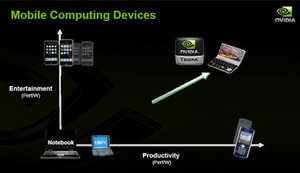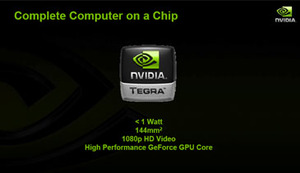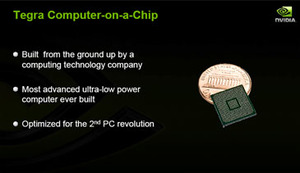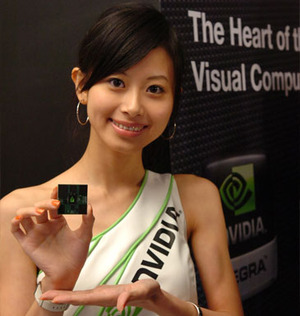
During a press conference in Taipei yesterday evening, Nvidia introduced the Tegra family of processors, which are designed for Mobile Internet Devices, sub-notebooks (or netbooks) and smartphones.
Tegra is a system on a chip that can play high-definition video and deliver a full Internet experience on hand-held devices. Nvidia says that we will likely this chip being used in devices with screen sizes ranging from four inches all the way up to 12 inches.
Nvidia made no mistake in highlighting that this is targeted squarely at Intel’s Centrino Atom platform, which is set for its official unveiling tomorrow here in Taipei.
The Tegra family of processors features an ARM11 CPU core, a GeForce graphics core, an HD video processor, an Image processor and a whole host of connectivity options – including an HDMI port. The three processors ship with different specifications and are split into two different usage models – the Tegra APX 2500, which was launched back in February without its brand name, is targeted at the smartphone market.
This features a 600MHz processor speed, a maximum LCD resolution of 854 x 480, and supports memory at 166MHz. With this, the chip is able to decode 720p h.264 video at 30 frames per second and Nvidia says it can also encode at the same resolution as well, although we are hard-pushed to see a reason to encode video on the move.
The remaining two models in the family, the Tegra 600 and Tegra 650 processors, are aimed more at the Mobile Internet Device and sub-notebook markets. The Tegra 600 includes a 700MHz CPU core, a maximum resolution of 1,280 x 1,024 and, like the APX 2500, it can decode 720p HD video at 30 frames per second. The most intriguing model in Nvidia’s new family is the high-end model, the Tegra 650, which features an 800MHz CPU clock, can support a maximum resolution of 1,680 x 1,050 and the company claims that it can decode 1080p HD video streams at 24 frames per second.
On paper, the specs sound impressive – but they only tell half the story. Nvidia claims that all configurations of the chip draw less than 1W of power at full load and it fits into a die that’s smaller than an English penny – it measures just 144mm². What’s more, with a battery no bigger than the one in Apple’s iPhone, Nvidia claims that it can get 26 hours of 720p, h.264 HD video playback and over 130 hours of audio.
We pressured Nvidia for details on the graphics core, but it didn’t seem to want to reveal all of the details. It supports the OpenGL ES 2.0 specification and is we’re told its performance is ‘close’ to the GeForce FX series of products – by that, we assume it’s about as fast as an FX 5200, not a GeForce FX 5950 Ultra, but Nvidia didn’t want to get into the details.
Nvidia has been making a lot of noise about CUDA on its desktop and notebook GPUs recently, saying on numerous occasions that CUDA is a key part of all of its GPU architectures these days. It seemed like an ideal question to put to Michael Rayfield, General Manager of Nvidia’s Mobile Business Unit.
His response felt a little caged and it felt as if he was holding something back for another date. Considering the fact that Rayfield has remained incredibly quiet about the graphics core in general—despite numerous attempts to gather more information—it makes us believe that the chip maybe does support CUDA. However, without confirmation from Nvidia, it’s hard to say for sure.
Our one major concern for the platform is its lack of x86 support, but Nvidia has been quick to play down x86 on a number of occasions. During our recent chat with David Kirk, one thing he mentioned when we drifted off topic was that he felt x86 was “a waste of die space these days.”
Tegra cannot run any operating system that supports x86 exclusively – so you can rule out MIDs running Windows XP or Windows Vista, which we think is a bit of a shame. Instead, Nvidia has teamed up with Microsoft and at least the first wave of devices will run Windows CE and Windows Mobile 6.0, with the option of a fully 3D user interface should device makers want to use that. Application support for this operating system is not brilliant, but Nvidia seemed confident that it could persuade developers, with the help of ARM and Microsoft, to develop software for the mobile OS.
Finally, I asked Rayfield about a future iPhone based on one of the Tegra chips, as Nvidia has quantified battery life in Tegra-based smartphones with an iPhone-sized battery because, after all, the current iPhone uses an ARM-based CPU core and the modified OSX obviously has built-in support. Rayfield said he’d love to see Apple embrace Nvidia’s technology, but he wouldn’t comment any further than that.
Do you think Tegra-based devices could deliver interesting opportunities in the world of smartphones and MIDs? Let us know your thoughts in the forums.
Tegra is a system on a chip that can play high-definition video and deliver a full Internet experience on hand-held devices. Nvidia says that we will likely this chip being used in devices with screen sizes ranging from four inches all the way up to 12 inches.
Nvidia made no mistake in highlighting that this is targeted squarely at Intel’s Centrino Atom platform, which is set for its official unveiling tomorrow here in Taipei.
The Tegra family of processors features an ARM11 CPU core, a GeForce graphics core, an HD video processor, an Image processor and a whole host of connectivity options – including an HDMI port. The three processors ship with different specifications and are split into two different usage models – the Tegra APX 2500, which was launched back in February without its brand name, is targeted at the smartphone market.
This features a 600MHz processor speed, a maximum LCD resolution of 854 x 480, and supports memory at 166MHz. With this, the chip is able to decode 720p h.264 video at 30 frames per second and Nvidia says it can also encode at the same resolution as well, although we are hard-pushed to see a reason to encode video on the move.
The remaining two models in the family, the Tegra 600 and Tegra 650 processors, are aimed more at the Mobile Internet Device and sub-notebook markets. The Tegra 600 includes a 700MHz CPU core, a maximum resolution of 1,280 x 1,024 and, like the APX 2500, it can decode 720p HD video at 30 frames per second. The most intriguing model in Nvidia’s new family is the high-end model, the Tegra 650, which features an 800MHz CPU clock, can support a maximum resolution of 1,680 x 1,050 and the company claims that it can decode 1080p HD video streams at 24 frames per second.
On paper, the specs sound impressive – but they only tell half the story. Nvidia claims that all configurations of the chip draw less than 1W of power at full load and it fits into a die that’s smaller than an English penny – it measures just 144mm². What’s more, with a battery no bigger than the one in Apple’s iPhone, Nvidia claims that it can get 26 hours of 720p, h.264 HD video playback and over 130 hours of audio.
We pressured Nvidia for details on the graphics core, but it didn’t seem to want to reveal all of the details. It supports the OpenGL ES 2.0 specification and is we’re told its performance is ‘close’ to the GeForce FX series of products – by that, we assume it’s about as fast as an FX 5200, not a GeForce FX 5950 Ultra, but Nvidia didn’t want to get into the details.
Nvidia has been making a lot of noise about CUDA on its desktop and notebook GPUs recently, saying on numerous occasions that CUDA is a key part of all of its GPU architectures these days. It seemed like an ideal question to put to Michael Rayfield, General Manager of Nvidia’s Mobile Business Unit.
His response felt a little caged and it felt as if he was holding something back for another date. Considering the fact that Rayfield has remained incredibly quiet about the graphics core in general—despite numerous attempts to gather more information—it makes us believe that the chip maybe does support CUDA. However, without confirmation from Nvidia, it’s hard to say for sure.
Our one major concern for the platform is its lack of x86 support, but Nvidia has been quick to play down x86 on a number of occasions. During our recent chat with David Kirk, one thing he mentioned when we drifted off topic was that he felt x86 was “a waste of die space these days.”
Tegra cannot run any operating system that supports x86 exclusively – so you can rule out MIDs running Windows XP or Windows Vista, which we think is a bit of a shame. Instead, Nvidia has teamed up with Microsoft and at least the first wave of devices will run Windows CE and Windows Mobile 6.0, with the option of a fully 3D user interface should device makers want to use that. Application support for this operating system is not brilliant, but Nvidia seemed confident that it could persuade developers, with the help of ARM and Microsoft, to develop software for the mobile OS.
Finally, I asked Rayfield about a future iPhone based on one of the Tegra chips, as Nvidia has quantified battery life in Tegra-based smartphones with an iPhone-sized battery because, after all, the current iPhone uses an ARM-based CPU core and the modified OSX obviously has built-in support. Rayfield said he’d love to see Apple embrace Nvidia’s technology, but he wouldn’t comment any further than that.
Do you think Tegra-based devices could deliver interesting opportunities in the world of smartphones and MIDs? Let us know your thoughts in the forums.

MSI MPG Velox 100R Chassis Review
October 14 2021 | 15:04














Want to comment? Please log in.